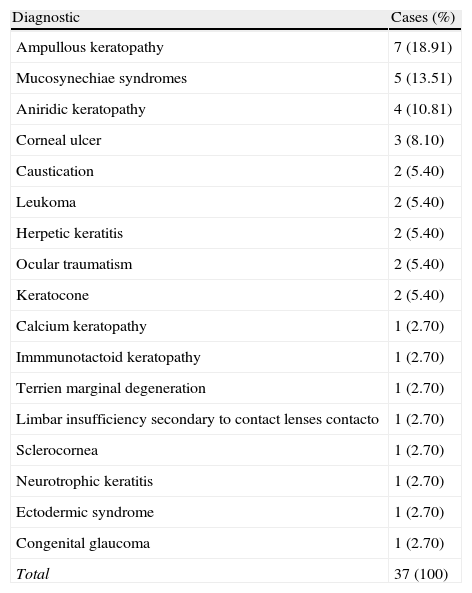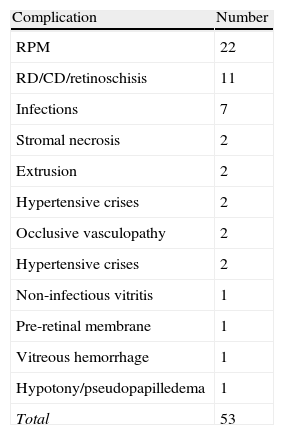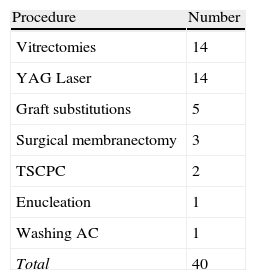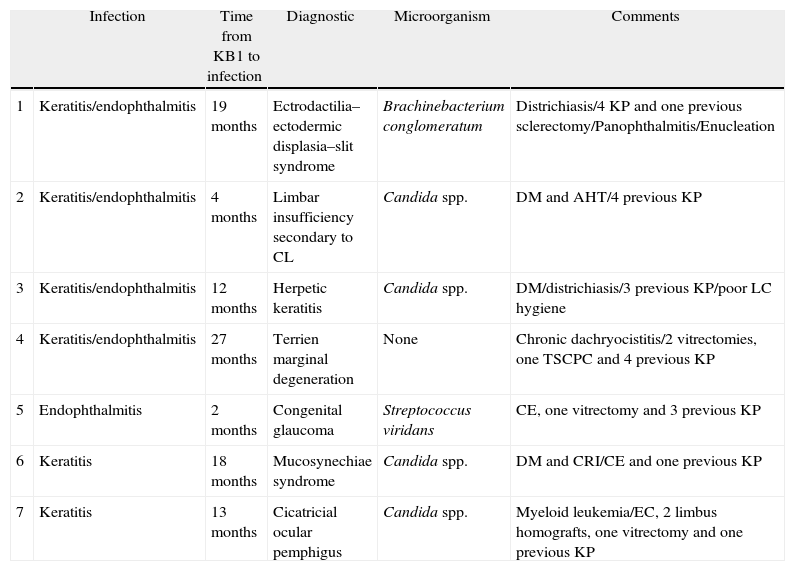To describe the visual outcome of patients who underwent Boston type 1 keratoprosthesis (KPro1) implantation, and describe serious sight-threatening post-operative complications.
MethodsWe performed an analysis of the clinical records of all patients who underwent Boston keratoprosthesis implantation (BKI) in our institution from May 2006 to February 2011.
ResultsA total of 41 eyes of 37 patients were included in the final analysis, of whom 22 (59.45%) were male and 15 were (40.54%) female. The mean age was 56.44 years (range 2–90). The most frequent diagnoses were bullous keratopathy, autoimmune diseases, such as Stevens–Johnson syndrome (SJS)/Lyell syndrome (LS), and aniridic keratopathy. The mean number of previous keratoplasties (PK) was 2.36 (range 0–8), and the mean number of previous non-PK surgeries was 1.58 (range 0–9). The mean follow-up time was 22.17 months (range 3–46). The mean best corrected visual acuity (BCVA) logMAR before surgery was 2.05 (range 1.10–2.52), and the mean best corrected visual acuity achieved after surgery was 1.16 (range 0.08–2.70). The most frequent complication was the formation of retroprosthetic membrane (RPM) which appeared in 22 (53.65%) eyes. Of these, 6 (27.27%) appeared after another surgery. Fourteen (63.63%) RPM required treatment, an average of 1.71 (range 1–4) laser YAG applications were performed, and surgical membranectomy was performed in 3 patients. Eleven (26.82%) eyes showed chorioretinal adhesion problems, 6 (14.63%) of which occurred after follow-up of BKI surgery. Infectious complications occurred in 7 (17.07%) cases; 2 (4.87%) patients had infectious keratitis and 5 (12.19%) endophthalmitis.
ConclusionsVisual function improved in most patients. Those with prior multiple ocular surgeries and alterations of systemic immunity such as SJS, LS, and diabetes mellitus are at increased risk for serious sight-threatening complications, such as RPM, chorioretinal detachment and infection. Nevertheless, we consider KPro as an effective alternative in patients with multiple ocular pathology and imminent risk of rejection of a new KP.
Describir el resultado visual de los pacientes intervenidos de queratoprótesis de Boston tipo 1 (QB1), así como las complicaciones postoperatorias graves que afecten a la visión en estos pacientes.
MétodosSe realizó un análisis de los expedientes clínicos de todos los pacientes que recibieron QB1 en nuestra institución de mayo de 2006 hasta febrero de 2011.
ResultadosEncontramos 41 ojos de 37 pacientes, 22 (59,45%) masculinos y 15 (40,54%) femeninos. La edad media fue de 56,44 años (rango 2-90). Los diagnósticos más frecuentes fueron la queratopatía ampollosa, enfermedades autoinmunes como el síndrome de Stevens-Johnson (SSJ)/síndrome de Lyell (SL) y queratopatía anirídica. El promedio de queratoplastias (QP) previas fue de 2,36 (rango 0-8) y el de cirugías oculares previas que no eran QP fue de 1,58 (rango 0-9). La media de seguimiento fue de 22,17 meses (rango 3-46). El promedio de la mejor agudeza visual corregida (MAVC) en escala de logMAR antes de la cirugía fue de 2,05 (rango 1,10-2,52) y la MAVC conseguida después de la cirugía fue de 1,16 (rango 0,08-2,70). La complicación más frecuente fue la formación de membrana retroprotésica (MRP), la cual apareció en 22 (53,65%) ojos. De estas, 6 (27,27%) fueron posteriores a otra cirugía. Requirieron tratamiento 14 (63,63%) MRP, un promedio de 1,71 (rango 1-4) aplicaciones de láser YAG y en tres pacientes membranectomía quirúrgica. En 11 (26,82%) ojos se presentaron problemas de adherencia coriorretinianos, seis (14,63%) de los cuales sucedieron después de otra cirugía posterior a la QB1. Complicaciones infecciosas se presentaron en siete (17,07%) casos, dos (4,87%) pacientes presentaron queratitis infecciosas y cinco (12,19%), endoftalmitis.
ConclusionesLa función visual mejoró en la mayoría de pacientes. Aquellos con múltiples cirugías oculares previas y alteraciones de la inmunidad sistémica como SSJ, SL o diabetes mellitus (DM) presentan un mayor riesgo de presentar complicaciones graves que afecten a la visión, como MRP, desprendimientos coriorretinianos e infecciones. A pesar de todo, consideramos que es una alternativa efectiva en pacientes con enfermedad ocular múltiple e inminente riesgo de rechazo de una nueva QP.















